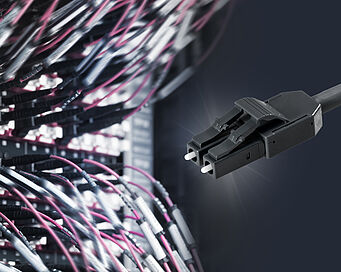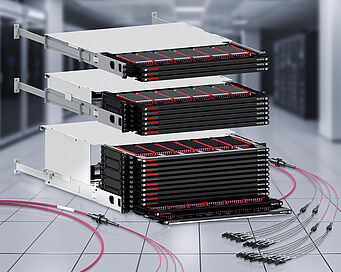Fast, reliable and easy to use? That is exactly the promise made by our new cabling system PreCONNECT® OCTO MDC and SN®. And today we'll be looking in detail at just what that means with our Product Manager, Harald! The system is said to deliver time savings of 75 % when installing trunks in 19-inch panels. Precisely how is this time calculated?
Harald Jungbäck: I won’t present a calculation like a maths teacher but instead I’ll show you with an example. What makes the system special is that we equip four duplex ports, here the SN® for example, with couplers ex-works, 4 port connections, that we can plug in four duplex ports at once during installation. That makes things very easy. Find the right number. Plug it in at the required location in the empty front plate. Done. Breathtakingly fast.
Compared to the conventional installation method. Four individual duplex connectors. Couplers in the front plate. Find the right one. Remove the protective cap. Take the protective plugs out of the coupler. Plug it in properly without getting it contaminated. And do that four times. One plug-in instead of four. That amounts to a time saving of 75%.
And time is money. That means that this approach also brings about enormous cost benefits. You also say that the system provides an optimum level of protection of the sensitive connector tip surfaces. What’s that all about?
Harald Jungbäck: II just touched on that briefly. The critical moment comes in when I plug in individual connectors. I have to remove the protective cap. And now any mistakes can be dangerous. If I touch them, I can contaminate the tip surfaces of the connector or even damage them if I insert them into the coupler from behind. And that’s simply not possible here. At no time is it possible for anyone to get to the sensitive tip surfaces. Touch them, damage them, contaminate them.
That’s naturally a crucial advantage, in particular at a time of skilled labour shortages. I mean if there is no trained fiber optics specialist around, and they’re becoming ever more difficult to find, then it’s very easy to use.
Harald Jungbäck: It’s absolutely safe to handle.
I’d like to say a bit more on the subject of the lack of skilled labour, because in particular in the case of systems with such high port densities, here we have 128 duplex ports per height unit, there can always be commutations between ports. So can our system help prevent these port swappers or even make them impossible?
Harald Jungbäck: Yes, of course, everyone can see that for themselves. We insert the ports in the correct sequence in the couplers ex-works. Of course, you can insert an entire block in the wrong place in the front plate. But it takes a lot of creativity to do that! But of course, if I’m plugging in individual connectors with this extremely high port density of 128 then the risk of swapping over the individual connectors between ports is very high. And this system makes that impossible.
So, here again, we see that it’s very simple and easy-to-use. In fact, it’s very intuitive. So what are the service capabilities of systems with such high port densities? How does the port break out actually work here?
Harald Jungbäck: Let’s look at a service case. One of the four duplex ports per block isn’t working. Errors occur so you have to use optical measurement technology, troubleshoot, and to do that you have to open up the lane somewhere. You can do that either directly at the front on the panel or at an individual plug connector at the trunk connector leg. Now it’s easy for me to take out the one that isn’t working and perform my service tasks. The other three continue to operate and are unaffected.
That means that it’s also an excellent solution for spine-leaf architectures.
Harald Jungbäck: The advantage with spine-leaf: Because the individual duplex ports lead away directly at this OCTO 4x block, it is possible to construct spine-leaf architectures with individual patchcords because the individual duplex ports lead away in their direction.
One major current issue is the constantly increasing demand for port density. So tell me how our new cabling system helps further increase port density?
Harald Jungbäck: Here again, it’s self-explanatory. A picture tells more than a thousand words. We can guide it from underneath. LC-Duplex, very popular nowadays. The maximum possible with LC-Duplex is a four-row layout with 96 LC-Duplex ports per height unit. That’s the physical limit, and here we have SN® and MDC with 128 duplex ports at one height unit. That’s the efficiency we’re able to achieve in terms of port density.
And this also helps improve energy efficiency and sustainability in data centers.
Harald Jungbäck: Yes, you can see how that works. Such high-density panels take up less space in the rack, meaning that less of the valuable, expensive cooled space in the data center is used. This improves energy efficiency and makes a positive contribution to data center sustainability.
All in all, our new PreCONNECT® OCTO MDC and SN® cabling system therefore not only offers ideal functionality, but also makes an important contribution to improving efficiency in terms of costs, time and port density.
More information about PreCONNECT® OCTO MDC and SN® you can find here.



